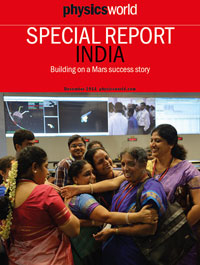By Michael Banks

This year has been one of change for India. In May, some 800 million eligible voters went to the polls in an election that was won by the Bhartiya Janata Party. Led by Narendra Modi, the party went on to form a coalition government called the National Democratic Alliance.
Our Special Report, which you can read free online, kicks off by looking at how science is faring under Modi’s fledgling administration. Indeed, in September, Modi was personally on hand at the Indian Space Research Organisation (ISRO) to laud engineers who had just carefully manoeuvred the Mars Orbiter Mission into position around the red planet – a feat that announced India as a major player in space exploration.
Modi’s personal interest in ISRO will not only please the organization’s chairman K Radhakrishnan, who we interview for the report, but could also be seen as a sign that the new administration is serious about boosting science in the country.
Yet for all the success this year, challenges still remain. Our report also takes a look at India’s education system, which continues to support its top research institutes but leaves lower-tier universities well behind, as well as how more could be done to boost science communication and international collaboration.
I hope you find this special report stimulating and please do let us have your comments by e-mailing pwld@iop.org or leaving your remarks below.
Here is a rundown of what is in the 2014 India special report.
• New government promises science fillip – After India elected a new prime minister this year, Pallava Bagla looks at how science will fare under the administration of Narendra Modi.
• Exploring the cosmos – K Radhakrishnan, chairman of the Indian Space Research Organisation, outlines bold plans to send a manned mission into space.
• Educating India – State universities are losing out to India’s world-leading research institutes when it comes to funding and attracting the best researchers, as T V Padma finds out.
• Enthusing the masses – Kanchan Chowdhury, physics curator of the National Council of Science Museums, discusses how to boost science communication In India.
• Going global – India has contributed to a host of experiments at CERN and Fermilab, but challenges remain to develop the technical skills needed to build its own collider, as T V Padma reports.
This special report is published by Physics World – the member magazine of the Institute of Physics (IOP) that appears 12 times a year. If you’d like to read Physics World each month, you can do so via the digital version of the magazine or via the Physics World app, available from the App Store and Google Play. If you’re not yet in the IOP, you can join as an IOPimember for just £15, €20 or $25 a year to get a full 12 months’ access to Physics World both online and through the apps.
Apart from the well-run space-agency and its achievements, most of India’s scientific institutions like its overall infrastructure, are just in an early fledging state compared to China that has already well-funded and well-run scientific organisations along with a highly uptodate infrastruture system plus China has just become the ppp-normalised
first economic power in the world – all of this achieved in a one generation!
Trackback: Physics Viewpoint | Physics World Special Report: India
Congratulationns to India